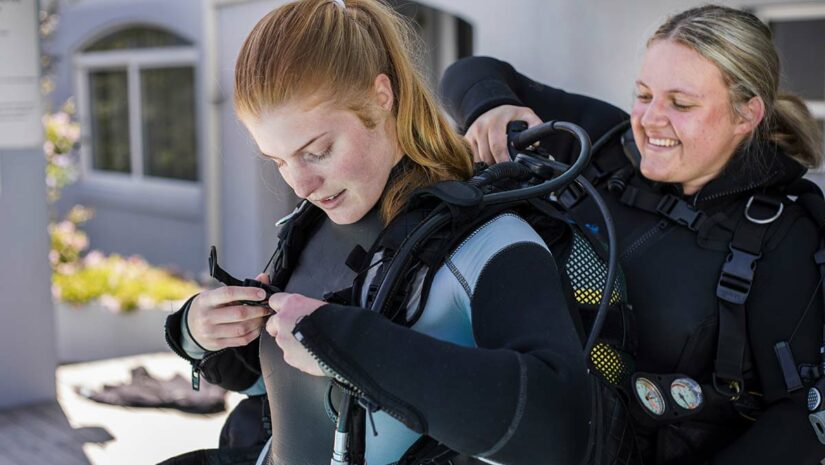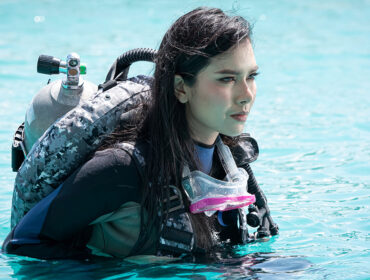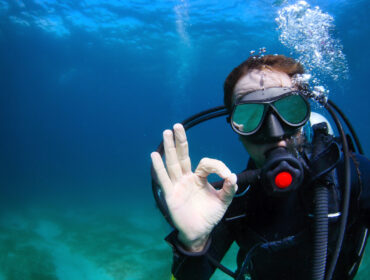Never dive alone — this is the number one rule of scuba diving. This goes for everyone, whether you have 10 dives or 10,000 dives in your log book. There’s always a chance that something could go wrong underwater, and it’s important to know that you have someone close by to help you if needed. But a dive buddy isn’t just there for emergencies. A dive buddy is also a friend and someone to swap stories with, and create memories with.
So what makes a good dive buddy, and how can you be a better one? Let’s find out.
What is the role of a dive buddy?
A dive buddy is a fellow diver who you will be looking out for during the dive, and who will be looking out for you in the same way.
Your role as a buddy is primarily for safety and to be there to provide air if your dive buddy should need it. You should have enough experience and training to handle an emergency situation with confidence. This is why taking courses is essential in scuba diving. The Open Water course teaches you not only how to dive well, but how to be a good dive buddy. You learn how to react in an out of air scenario, as well as other skills that will make you a good buddy. You can expand your knowledge and experience by going on to do further diving education.
A good dive buddy will have well maintained equipment that can be relied on. This is for your own sake as well as your buddy’s. Make sure to have your regulators checked regularly, as well as your tanks if you have your own.
A dive buddy also acts as a role model. If you are more experienced than your buddy, you should take it upon yourself to show them how a good diver behaves. That means following the rules, staying within your diving limits, not touching or chasing marine life, and being kind and helpful to less experienced divers.

The buddy check
The buddy check is something you learn in your Open Water course. It’s a pre-dive check that you should perform with your buddy before entering the water to dive. Even if you are a very experienced diver, it’s important not to skip the buddy check. Even expert or professional scuba divers can forget a small detail, but that small detail could turn into a big problem underwater. For example not checking if your air is turned on is potentially dangerous if you hit the water and can’t inflate your BCD. Not checking if your weights are securely fastened could result in you losing them when you jump in. In both cases, your dive is over before you’ve even started.
The buddy check can be easily remembered by using the acronym BWRAF:
B: BCD
Check your buddy’s buoyancy control device fully inflates using the inflator hose, deflates using the inflator hose and the dump valves, and inflates orally. Make sure there are no holes or rips in the BCD.
W: Weights
Check your buddy’s weight belt is securely fastened, and that it is right hand release and not wrapped around or tied up, this is to ensure quick release in an emergency. If your buddy’s weights are integrated, check they are securely in place and that you know how to release them quickly if needed.
R: Releases
Check that all of the releases are secure and tight. That includes the release on the tank so it won’t slide out. As well as the clips on the BCD waist, chest, and shoulders.
A: Air
This is obviously an important check. First, make sure that the needle on the submersible pressure gauge (SPG) is pointing at zero while the air is turned off. Next, turn the air on by rotating the handle all the way, and then a quarter turn back. You are going to check one person’s air at a time by both taking a regulator each from the same equipment set (you need to know the regulators can handle two people breathing simultaneously). They will take their primary regulator and you will take the spare.
First, press the purge button a little and smell the air that comes out to make sure it doesn’t smell bad. It should just smell like nothing, or maybe slightly of rubber, but nothing bad such as petrol. Next you should both put the regulators in your mouths and breathe at the same time. While you do this you should watch the needle on the SPG to make sure it’s not bouncing up and down while you breathe. Once you’ve checked theirs, you switch and do the same with yours.
F: Final check
Make sure that you and your buddy have everything you need for the dive. That includes fins, mask, snorkel, computer, and any extras such as cameras and tank bangers.
PADI suggests using the mnemonic “Begin With Review And Friend” to remember the buddy check. But many scuba divers come up with funny acronyms, such as “Bruce Willis Ruins All Films” or “Because We Really Aren’t Fish”. Maybe you can come up with your own to help you to remember.
If there is an odd number of people in the dive group, it is acceptable to have a buddy team of three. No one should be left to dive without a buddy.

9 tips to be a better dive buddy
1. Get chummy with new buddies
Not everyone is lucky enough to always dive with their close friends. From time to time you might find yourself on a dive trip with strangers. But a stranger is just a buddy you haven’t met yet! After all, you all have one awesome thing in common… scuba diving! And once divers start talking about their best diving memories, or comparing their favorite fish, conversations can go for hours, and before you know it you have new lifelong dive buddies to plan future trips with.
It’s also important to trust the people you’re diving with. You need to know that in an emergency, they will have your back. It’s a lot harder to trust someone you’ve never even spoken to, so don’t be shy to get to know the other divers on the trip before taking the plunge.
2. Go over hand signals together
Remember, your voice doesn’t work underwater. It’s important to go over hand signals with your dive buddy beforehand. Basic hand signals include “OK” (question and answer), “up”, “down”, “how much air do you have?” (and how to answer this question is very important: “low on air”, “out of air”, “I’m cold”, “turn around”, ”look”, ”come up/down to my level”, “safety stop”).
You can also learn the hand signals for the fish you are likely to see at this dive spot, so you can point things out to each other along the way. It’s important to feel confident that you can communicate with your buddy underwater, and also that they can understand you when you do.
3. Plan the dive and dive the plan
This is a common phrase you might hear in the scuba world. But it is an important rule. Having a dive plan and discussing it with your buddy/group is a key part of making sure a dive goes smoothly and safely. Planning a dive should include things like:
- How and where you will enter the water
- Who is guiding/leading the dive
- Which dive site you will be going to
- Does everyone have a dive buddy?
- When will you turn the dive and head back?
- Will you be drifting? If so, where will the boat pick you up or where will you exit?
- What to do if you lose your buddy/group
- What to do if you hit strong currents
- How and where to do the safety stop
- How and where to exit the water
4. Stay close
A rough rule is to stay around 10-13ft (3-4m) close to your dive buddy in good visibility. However, you might choose to stay a little closer in poorer visibility. Losing your dive buddy will mean that you’ll have to surface, and your dive is probably over earlier than it needed to be. You should always be able to see your buddy. In very bad visibility you could even use a buddy line or tether to stay close. It’s important to keep your buddy close for both of your safety. If you were to run low on air, or get badly hurt underwater you can turn to your buddy for help, and vice versa.

5. Respect your fishy friends
Most people dive to see the wonderful, vibrant world that hides under the waves. From the biggest whale, to the tiniest shrimp, it’s so important that we respect them and their environment. That means no touching! It can be tempting to stroke the shell of a beautiful sea turtle, but touching marine life can damage their skin or surface, it can potentially harm you, and it will probably scare the animal away and then you and your buddies can no longer admire it. Being a good dive buddy means respecting all sea life (not just other divers).
6. Handle issues well
If your buddy doesn’t respect a rule, or you believe they are doing something wrong, it’s good to kindly educate them. Not everyone knows that what they are doing is wrong (touching coral or swimming far away from their dive buddy, for example). So approach the matter in a calm way. If underwater, tap them gently on the shoulder and use hand signals like waving your finger to say “don’t do that”, shake your head, or signal “stay closer” by moving your two index fingers together side by side.
You can approach the diver after the dive and talk to them nicely about what they did, and try to explain why it wasn’t good diving practice. Most people are understanding and the conversation should go well. If they refuse to accept your feedback, you can refuse to dive with them again, or approach the dive guide/center. It’s also good to accept constructive criticism that your buddy might approach you with.
7. Exit the water safely and together
Stay close for the safety stop, and surface together. Once at the surface, make your way to the boat or exit and work together to get out. You can help by holding each other’s fins, supporting the tank, or helping each other take off the BCD. Working as a team is key to being a good buddy.
8. Share the love
Get your buddy’s email address, Facebook, Instagram, etc. and swap photos, tag them in yours, and post about your experience with your dive buddy and all the amazing things you saw on the dive. Make sure to stay in touch for planning future dive trips together.
9. Education is power
A good dive buddy never stops learning. There is so much to get better at in scuba diving, and you can always improve skills. The better your diving technique is, and the more experienced you are, the better you can do your job as a dive buddy. You can take part in courses to expand your knowledge and experience such as; Peak Performance Buoyancy, Underwater Photography, Deep Diver, Wreck Diver, Rescue Diver, and more. There’s also thousands of blogs, articles, books, podcasts, and documentaries out there in the scuba diving niche to further quench your thirst for scuba knowledge.
Now you have all the information you need to be a better buddy, and know what to expect from your dive buddies in the future.
Can you think of more ways to be a better dive buddy? Has your dive buddy ever had to help you out of a tricky situation? Let us know.
Written by: Charlotte Stringer





